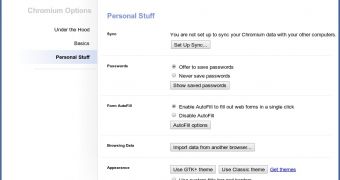For two decades now, software developers have relied on modal windows to enable users to tweak their applications to their liking. Google, though a web company at heart, opted for the same thing when it launched Chrome. Despite the browser not following that many ‘standard’ design principles, it didn’t fall out of line in this case.
The reason is simple, it’s easier to rely on the components put at your disposal by the operating system rather than create your own. But now, at this stage of development, the Google Chrome team thinks it’s about time to ditch the dedicated windows and do everything within the tabs.
The latest example is the in-tab options menu which is still under heavy development. It’s not enabled by default even in the most experimental builds, Chromium or Chrome Canary, but it starting to be on par with the regular options menu. To enable it, run Chromium or Chrome dev with the “–enable-tabbed-options” command line switch.
Already, most of the options are available with just some sub-menus still inaccessible. But progress is swift so the feature should be landing soon enough in the dev channel builds. Earlier this year, the bookmarks menu, which initially had its own window, was replaced with an in-tab bookmarks manager. And Google is not the only one doing this, Mozilla is moving in the same direction with Firefox 4. One of the first examples is the in-tab Add-On manager introduced with the first betas of the upcoming browser.
There are good reasons for doing this. For one, it simplifies the work for developers of cross-platform apps. Instead of having to write code three times, once for Windows, once for Linux and once for Mac, developers can do it once, using HTML and web technologies, and use the browser’s rendering engine to display the menus, the same ones on each platform.
But Google has another reason, the impending launch of Google Chrome OS. The upcoming operating system uses Linux underpinnings, but the developers have tried to do everything inside the browser. Until now, the Options menu relied on the GTK libraries, but once the team manages to move everything inside the browser, it can shed off even more ‘weight’ by removing them completely. [via Download Squad]

 14 DAY TRIAL //
14 DAY TRIAL //